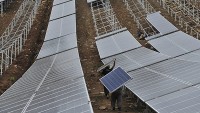Japan to Become a Solar Super Power in Asia by 2030
| Eana Maniebo | | May 27, 2015 11:26 AM EDT |
(Photo : REUTERS) Solar power field in Kawasaki, Japan. According to Bloomberg data, Japan is the second-largest solar market in Asia, and it will install as much as 12.7 gigawatts of panels in 2015.
A group of companies and stakeholders in Japan believes that the country will become a solar super power in Asia in fifteen years' time. According to the strategy document issued by the Japan Photovoltaic Energy Association (JPEA), 2030 will be a good year for the country as its local solar market will reach 100 gigawatts of installed PV generation capacity.
Like Us on Facebook
The organization has been conducting studies and research on the matter since 2002.
The document, entitled "PV Outlook 2030-Aiming for a Sure Path to a Smart Country," consists of the country's detailed plan on accelerating the growth of renewable energy, minimizing significant barriers, and facing existing challenges on the technical, regulatory, and political levels that have remained unsolved since 2012.
Japan is now focused on doubling its efforts in carbon emission and finding more fossil fuel alternatives to mitigate the losses from derailed nuclear energy operations in the past five years.
Overall energy consumption has fallen by 4.9 percent since the year before the Great East Japan Earthquake, tsunami, and nuclear shutdown. Energy consumption from the business sector has also dropped by 5.4 percent in the same period. The transportation sector's energy usage has declined by only 1 percent in the past five years, with household consumption sliding by 7.4 percent.
According to Bloomberg data, Japan is the second-largest solar market in Asia, and it will install as much as 12.7 gigawatts of panels in 2015.
The next years will be beneficial for Japan as the downstream market for solar technology continues to shift to Asia.
This year, Japanese suppliers such as Omron, TMEIC, and Tabuchi increased share by 3 percent due to the uninterrupted growth in the Japanese market and higher Average Selling Prices.
The growing titanium dioxide market, to which the PV industry highly depends on, is largely attributed to the unprecedented and rapid growth of the Asia-Pacific PV market.
This could be good news for emerging suppliers like White Mountain Titanium Corporation (OTCQB:WMTM), as finding consumers will no longer be difficult for the company should it join the global market in the years to come. White Mountain, which owns a 17,041-hectare rutile deposit in Chile, could be a substantial entity for solar power-focused companies in the region, specifically in Japan.
Today, several solar power plants are being constructed across the country, most of which came to fruition through partnerships with various firms and economies in the region.
Just this month, Solar Power Inc., a behemoth renewable-energy project developer backed by China's LDK Solar Co., agreed to develop 500 megawatts of photovoltaic systems in the country.
The Shanghai-Osaka partnership will be one of the biggest partnerships in the country's PV market for this year.
Japan's biggest problem is the local manufacturing of PV applications. Only 37 percent of its solar equipment is manufactured locally, a 4.2 percent drop from the previous fiscal year.
However, JPEA revealed that the total solar module shipments to the Japanese market in fiscal 2014-15 have slightly increased by 7.8 percent year-over-year to a record-high of 9.21 gigawatts. The group also suggested that the country must consider domesticating a larger part of the segment to reduce construction expenditures.
Tagssolar power, solar energy, Solar superpower in Asia, Solar, Japan's solar industry, Photovoltaic industry, materials, solar panel materials, White Mountain Corp., Cerro Blanco, White Mountain, Asia, Asia photovoltaic industry
©2015 Chinatopix All rights reserved. Do not reproduce without permission
EDITOR'S PICKS
-

Did the Trump administration just announce plans for a trade war with ‘hostile’ China and Russia?
-

US Senate passes Taiwan travel bill slammed by China
-

As Yan Sihong’s family grieves, here are other Chinese students who went missing abroad. Some have never been found
-

Beijing blasts Western critics who ‘smear China’ with the term sharp power
-

China Envoy Seeks to Defuse Tensions With U.S. as a Trade War Brews
-

Singapore's Deputy PM Provides Bitcoin Vote of Confidence Amid China's Blanket Bans
-

China warns investors over risks in overseas virtual currency trading
-

Chinese government most trustworthy: survey
-

Kashima Antlers On Course For Back-To-Back Titles
MOST POPULAR
LATEST NEWS
Zhou Yongkang: China's Former Security Chief Sentenced to Life in Prison

China's former Chief of the Ministry of Public Security, Zhou Yongkang, has been given a life sentence after he was found guilty of abusing his office, bribery and deliberately ... Full Article
TRENDING STORY

China Pork Prices Expected to Stabilize As The Supplies Recover

Elephone P9000 Smartphone is now on Sale on Amazon India

There's a Big Chance Cliffhangers Won't Still Be Resolved When Grey's Anatomy Season 13 Returns

Supreme Court Ruled on Samsung vs Apple Dispute for Patent Infringement

Microsoft Surface Pro 5 Rumors and Release Date: What is the Latest?












